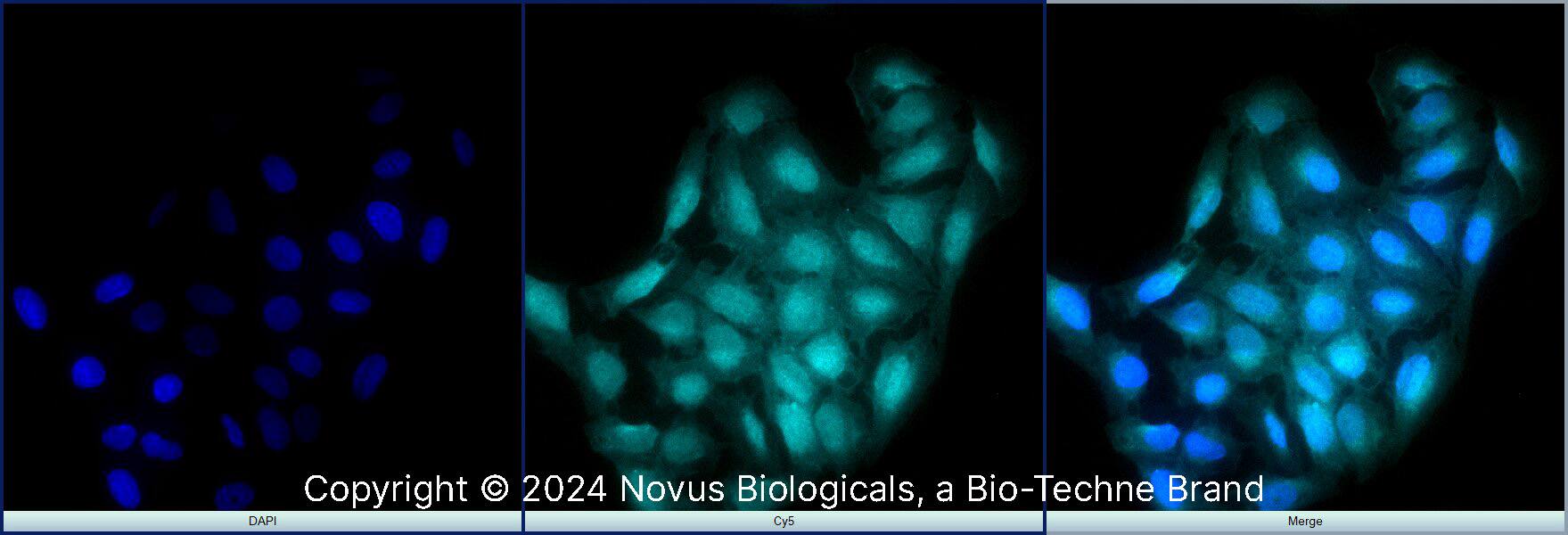BMAL1 Antibody - BSA Free
Novus Biologicals, part of Bio-Techne | Catalog # NB100-2288

![Western Blot: BMAL1 Antibody [NB100-2288] Western Blot: BMAL1 Antibody [NB100-2288]](https://resources.bio-techne.com/images/products/BMAL1-Antibody-Western-Blot-NB100-2288-img0021.jpg)
Conjugate
Catalog #
Key Product Details
Validated by
Knockout/Knockdown, Biological Validation
Species Reactivity
Validated:
Human, Mouse, Rat, Amphibian, Primate
Cited:
Human, Mouse, Rat
Applications
Validated:
Knockout Validated, Immunohistochemistry, Immunohistochemistry-Paraffin, Immunohistochemistry-Frozen, Western Blot, Flow Cytometry, Flow (Intracellular), Immunocytochemistry/ Immunofluorescence, Chromatin Immunoprecipitation (ChIP)
Cited:
Immunohistochemistry, Immunohistochemistry-Paraffin, Immunohistochemistry-Frozen, Western Blot, Immunocytochemistry/ Immunofluorescence, Chemotaxis, IF/IHC, Knockdown Validated
Label
Unconjugated
Antibody Source
Polyclonal Rabbit IgG
Format
BSA Free
Concentration
1.0 mg/ml
Product Specifications
Immunogen
Bacterially expressed human BMAL1 (amino acids 392-626). [UniProt# O00327].
Reactivity Notes
Mouse reactivity reported in scientific literature (PMID:32732906). Amphibian reactivity reported from a verified customer review.
Localization
Nuclear
Clonality
Polyclonal
Host
Rabbit
Isotype
IgG
Theoretical MW
70 kDa.
Disclaimer note: The observed molecular weight of the protein may vary from the listed predicted molecular weight due to post translational modifications, post translation cleavages, relative charges, and other experimental factors.
Disclaimer note: The observed molecular weight of the protein may vary from the listed predicted molecular weight due to post translational modifications, post translation cleavages, relative charges, and other experimental factors.
Description
Novus Biologicals Knockout (KO) Validated Rabbit BMAL1 Antibody - BSA Free (NB100-2288) is a polyclonal antibody validated for use in IHC, WB, Flow, ICC/IF and ChIP. Anti-BMAL1 Antibody: Cited in 75 publications. All Novus Biologicals antibodies are covered by our 100% guarantee.
Scientific Data Images for BMAL1 Antibody - BSA Free
Western Blot: BMAL1 Antibody [NB100-2288]
BMAL1-Antibody-Western-Blot-NB100-2288-img0021.jpgImmunohistochemistry: BMAL1 Antibody [NB100-2288]
Immunohistochemistry: BMAL1 Antibody [NB100-2288] - Analysis of BMAL1 in mouse cerebral cortex (left: wt, right: Bmal1 KO) using anti-BMAL1 antibody. Image from verified customer review.Applications for BMAL1 Antibody - BSA Free
Application
Recommended Usage
Immunocytochemistry/ Immunofluorescence
1:100
Immunohistochemistry
1:250. Use reported in scientific literature (PMID 33510438)
Immunohistochemistry-Frozen
reported in scientific literature (PMID 23736292)
Immunohistochemistry-Paraffin
1:250
Western Blot
0.5 ug/mL - 2 ug/mL
Application Notes
In ICC/IF, primarily nuclear staining was observed with weak cytoplasmic staining in MCF7 cells. In Western Blot, a band was observed ~70 kDa. In IHC-P, staining was observed in the nuclei of mouse brain tissue. Prior to immunostaining paraffin tissues, antigen retrieval with sodium citrate buffer (pH 6.0) is recommended. The observed molecular weight of the protein may vary from the listed predicted molecular weight due to post translational modifications, post translation cleavages, relative charges, and other experimental factors.
Reviewed Applications
Read 2 reviews rated 4 using NB100-2288 in the following applications:
Formulation, Preparation, and Storage
Purification
Immunogen affinity purified
Formulation
PBS
Format
BSA Free
Preservative
0.02% Sodium Azide
Concentration
1.0 mg/ml
Shipping
The product is shipped with polar packs. Upon receipt, store it immediately at the temperature recommended below.
Stability & Storage
Store at 4C for up to 3 months. For longer storage, aliquot and store at -20C.
Background: BMAL1
Long Name
Brain and Muscle ARNT-Like 1
Alternate Names
ARNTL, BHLHE5, BMAL1c, JAP3, MOP3, PASD3, TIC
Gene Symbol
BMAL1
Additional BMAL1 Products
Product Documents for BMAL1 Antibody - BSA Free
Product Specific Notices for BMAL1 Antibody - BSA Free
This product is for research use only and is not approved for use in humans or in clinical diagnosis. Primary Antibodies are guaranteed for 1 year from date of receipt.
Loading...
Loading...
Loading...
Loading...
Loading...
![Immunohistochemistry: BMAL1 Antibody [NB100-2288] Immunohistochemistry: BMAL1 Antibody [NB100-2288]](https://resources.bio-techne.com/images/products/BMAL1-Antibody-Chromatin-Immunoprecipitation-NB100-2288-img0018.jpg)
![Immunohistochemistry: BMAL1 Antibody [NB100-2288] Immunohistochemistry: BMAL1 Antibody [NB100-2288]](https://resources.bio-techne.com/images/products/BMAL1-Antibody-Immunocytochemistry-Immunofluorescence-NB100-2288-img0024.jpg)
![Western Blot: BMAL1 Antibody [NB100-2288] Western Blot: BMAL1 Antibody [NB100-2288]](https://resources.bio-techne.com/images/products/BMAL1-Antibody-Western-Blot-NB100-2288-img0023.jpg)
![Immunocytochemistry/ Immunofluorescence: BMAL1 Antibody [NB100-2288] Immunocytochemistry/ Immunofluorescence: BMAL1 Antibody [NB100-2288]](https://resources.bio-techne.com/images/products/BMAL1-Antibody-Immunocytochemistry-Immunofluorescence-NB100-2288-img0022.jpg)
![Flow (Intracellular): BMAL1 Antibody [NB100-2288] Flow (Intracellular): BMAL1 Antibody [NB100-2288]](https://resources.bio-techne.com/images/products/BMAL1-Antibody-Flow-Intracellular-NB100-2288-img0017.jpg)
![Immunohistochemistry: BMAL1 Antibody [NB100-2288] Knockout Validated: BMAL1 Antibody [NB100-2288]](https://resources.bio-techne.com/images/products/BMAL1-Antibody-Knockout-Validated-NB100-2288-img0020.jpg)
![Flow Cytometry: BMAL1 Antibody [NB100-2288] Flow Cytometry: BMAL1 Antibody [NB100-2288]](https://resources.bio-techne.com/images/products/BMAL1-Antibody-Flow-Cytometry-NB100-2288-img0019.jpg)
![Western Blot: BMAL1 Antibody [NB100-2288] Western Blot: BMAL1 Antibody [NB100-2288]](https://resources.bio-techne.com/images/products/BMAL1-Antibody-Western-Blot-NB100-2288-img0014.jpg)
![Western Blot: BMAL1 Antibody [NB100-2288] Western Blot: BMAL1 Antibody [NB100-2288]](https://resources.bio-techne.com/images/products/BMAL1-Antibody-Western-Blot-NB100-2288-img0016.jpg)
![Immunocytochemistry/ Immunofluorescence: BMAL1 Antibody [NB100-2288] Immunocytochemistry/ Immunofluorescence: BMAL1 Antibody [NB100-2288]](https://resources.bio-techne.com/images/products/BMAL1-Antibody-Immunocytochemistry-Immunofluorescence-NB100-2288-img0012.jpg)
![Immunohistochemistry: BMAL1 Antibody [NB100-2288] Immunohistochemistry: BMAL1 Antibody [NB100-2288]](https://resources.bio-techne.com/images/products/BMAL1-Antibody-Immunohistochemistry-NB100-2288-img0009.jpg)
![Immunohistochemistry-Paraffin: BMAL1 Antibody [NB100-2288] Immunohistochemistry-Paraffin: BMAL1 Antibody [NB100-2288]](https://resources.bio-techne.com/images/products/BMAL1-Antibody-Immunohistochemistry-Paraffin-NB100-2288-img0015.jpg)
![Immunohistochemistry-Frozen: Rabbit Polyclonal BMAL1 Antibody [NB100-2288] - BMAL1 Antibody](https://resources.bio-techne.com/images/products/antibody/nb100-2288_rabbit-polyclonal-bmal1-antibody-immunohistochemistry-frozen-7112023135159..png)

![Immunocytochemistry/ Immunofluorescence: BMAL1 Antibody [NB100-2288] - BMAL1 Antibody](https://resources.bio-techne.com/images/products/nb100-2288_rabbit-polyclonal-bmal1-antibody-31020241534364.jpg)
![Western Blot: BMAL1 Antibody [NB100-2288] - BMAL1 Antibody](https://resources.bio-techne.com/images/products/nb100-2288_rabbit-polyclonal-bmal1-antibody-310202415171349.jpg)
![Western Blot: BMAL1 Antibody [NB100-2288] - BMAL1 Antibody](https://resources.bio-techne.com/images/products/nb100-2288_rabbit-polyclonal-bmal1-antibody-310202415304255.jpg)
![Western Blot: BMAL1 Antibody [NB100-2288] - BMAL1 Antibody](https://resources.bio-techne.com/images/products/nb100-2288_rabbit-polyclonal-bmal1-antibody-31020241538245.jpg)
![Western Blot: BMAL1 Antibody [NB100-2288] - BMAL1 Antibody](https://resources.bio-techne.com/images/products/nb100-2288_rabbit-polyclonal-bmal1-antibody-31020241534379.jpg)
![Western Blot: BMAL1 Antibody [NB100-2288] - BMAL1 Antibody](https://resources.bio-techne.com/images/products/nb100-2288_rabbit-polyclonal-bmal1-antibody-31020241534315.jpg)
![Western Blot: BMAL1 Antibody [NB100-2288] - BMAL1 Antibody](https://resources.bio-techne.com/images/products/nb100-2288_rabbit-polyclonal-bmal1-antibody-31020241535633.jpg)
![Western Blot: BMAL1 Antibody [NB100-2288] - BMAL1 Antibody](https://resources.bio-techne.com/images/products/nb100-2288_rabbit-polyclonal-bmal1-antibody-310202415363747.jpg)
![Immunocytochemistry/ Immunofluorescence: BMAL1 Antibody [NB100-2288] - BMAL1 Antibody](https://resources.bio-techne.com/images/products/nb100-2288_rabbit-polyclonal-bmal1-antibody-310202415523930.jpg)
![Immunohistochemistry: BMAL1 Antibody [NB100-2288] - BMAL1 Antibody](https://resources.bio-techne.com/images/products/nb100-2288_rabbit-polyclonal-bmal1-antibody-310202415525251.jpg)